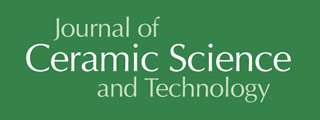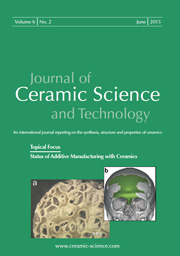Articles
All articles | Recent articles
Improved Flexural Strength in Digital-Light-Processing-Printed Si3N4 Ceramics by Removing Carbon Residue
B. Jin1, Y. Bian1, Y. Shen1, B. Xing1, M. Li2, Z. Zhao1
1 School of Materials Science and Engineering, Shanghai Institute of Technology, Shanghai, 201418, China
2 Jiaxing CeramPlus Technology Co., Ltd., Jiaxing, 314100, China
received January 7, 2022, received in revised form April 28, 2022, accepted May 5, 2022
Vol. 13, No. 2, Pages 99-106 DOI: 10.4416/JCST2022-00001
Abstract
The debinding step is vitally important to obtain defect-free ceramics in the fabrication of ceramics by means of DLP-3D printing. However, the residual carbon from the decomposition of the organic matter during the debinding process severely affects the quality and mechanical properties of the sintered ceramics. In this work, it has been proven that the carbon residue can participate in a carbothermal reduction reaction at 1 300 °C and lead to the formation of macroscopic defects such as delamination and cracks that occurred in the surface of the sintered silicon nitride ceramics. Based on this, we propose an approach to eliminate the carbon retained in silicon nitride compacts fabricated with the stereolithography technique. The amount of carbon residue that remained in the debinded silicon nitride bodies is 0.58 % based on thermogravimetric analysis in air atmosphere. When the oxidation temperature and holding time in the air were 450 °C and 5 h, respectively, the residual carbon in the samples could be sufficiently removed. The flexural strength of sintered ceramics without the removal of carbon residue is only 184.88 ± 8.16 MPa; sintered silicon nitride ceramics after removal of residual carbon can reach 469.78 ± 11.86 MPa. The research results in this study provide great reference value for the preparation of defect-free ceramics.
![]() Download Full Article (PDF)
Download Full Article (PDF)
Keywords
Keywords: Silicon nitride ceramics, DLP, residual carbon, flexural strength
References
1 Krstic, Z., Krstic, V.D.: Silicon nitride: the engineering material of the future, J. Mater Sci., 47, 535 – 552, (2012).
2 Ohji, T.: Microstructural design and mechanical properties of porous silicon nitride ceramics, Mater. Sci. Eng., 498, 5 – 11, (2008).
3 Ding, S., Zeng, Y.P., Jiang, D.: Oxidation bonding of porous silicon nitride ceramics with high strength and low dielectric constant, Mater. Lett., 61, 2277 – 2280, (2007).
4 Lu, H., Bailey, C., Yin, C.: Design for reliability of power electronics modules, Microelectron. Reliab., 49, 1250 – 1255, (2009).
5 Webster, T.J., Patel, A.A., Rahaman, M.N., Sonny Bal, B.: Anti-infective and osteointegration properties of silicon nitride, poly (ether ether ketone), and titanium implants, Acta Biomater., 8, 4447 – 4454, (2012).
6 Zhang, J.,Chen, J.W., Wang, H.J.: High performance porous wave-transmitting silicon nitride ceramics by gel-casting technique, Key Eng. Mater., 512, 869 – 872, (2012).
7 Rueschhoff, L.M., Trice, R.W., Youngblood, J.P.: Near-net shaping of silicon nitride via aqueous room-temperature injection molding and pressureless sintering, Ceram. Int., 43, 10791 – 10798, (2017).
8 Zou, C., Guo, S., Zhou, X., Li, S., Yan, C., Shen, T.: Gel-casting prepared porous Si3N4 ceramics with different contents of Y2O3 and Al2O3 additives, J. Mater. Eng. Perform., 29, 7891 – 7898, (2020).
9 Studart, A.R., Gonzenbach, U.T., Tervoort, E., Gauckler, L.J.: Processing routes to macroporous ceramics: a review, J. Am. Ceram. Soc., 89, 1771 – 1789, (2006).
10 Yang, X., Li, B., Zhang, C., Wang, S., Liu, K., Zou, C.: Fabrication and properties of porous silicon nitride wave-transparent ceramics via gel-casting and pressureless sintering, Mater. Sci. Eng., 663, 174 – 180, (2016).
11 Altun, A.A., Prochaska, T., Konegger, T., Schwentenwein, M.: Dense, strong, and precise silicon nitride-based ceramic parts by lithography-based ceramic manufacturing, Appl. Sci., 10, 996, (2020).
12 Ryan, K.R., Down, M.P., Banks, C.E.: Future of additive manufacturing: overview of 4D and 3D printed smart and advanced materials and their applications, Chem. Eng. J., 403, 126162, (2021).
13 Hwa, L.C., Rajoo, S., A.M. Noor, N. Ahmad, M.B. Uday: Recent advances in 3D printing of porous ceramics: A review, Curr. Opin. Solid State Mater. Sci., 21, 323 – 347, (2017).
14 G. Ding, R. He, K. Zhang, M. Xia, C. Feng, D. Fang: Dispersion and stability of SiC ceramic slurry for stereolithography, Ceram. Int., 46, 4720 – 4729, (2020).
15 Shen, M., Zhao, W., Xing, B., Sing, Y., Gao, S., Wang, C., Zhao, Z.: Effects of exposure time and printing angle on the curing characteristics and flexural strength of ceramic samples fabricated via digital light processing, Ceram. Int., 46, 24379 – 24384, (2020).
16 Schmidt, J., Colombo, P.: Digital light processing of ceramic components from polysiloxanes, J. Eur. Ceram. Soc., 38, 57 – 66, (2018).
17 Zakeri, S., Vippola, M., Levänen, E.: A comprehensive review of the photopolymerization of ceramic resins used in stereolithography, Addit. Manuf., 35, 101177, (2020).
18 Tomeckova, V., Halloran, J.W.: Predictive models for the photopolymerization of ceramic suspensions, J. Eur. Ceram. Soc., 30, 2833 – 2840, (2010).
19 Chen, Z., Li, J., Liu, C., Liu, Y., Zhu, J.Lao, C.: Preparation of high solid loading and low viscosity ceramic slurries for photopolymerization-based 3D printing, Ceram. Int., 45, 11549 – 11557, (2019).
20 Rasaki, S.A., Xiong. D., Xiong, S., Su, F.,Idrees, M., Chen, Z.: Photopolymerization-based additive manufacturing of ceramics: A systematic review, J. Adv. Ceram., 10, 442 – 471, (2021).
21 Hinczewski, C., Corbel, S., Chartier, T.: Ceramic suspensions suitable for stereolithography, J. Eur. Ceram. Soc., 18, 583 – 590, (1998).
22 Li, X., Zhang, J., Duan, Y., Liu, N., Jiang, J.: Rheology and curability characterization of photosensitive slurries for 3D printing of Si3N4 ceramics, Appl. Sci., 10, 6438, (2020).
23 Huang, R.J., Jiang, Q.G., Wu, H.D.: Fabrication of complex shaped ceramic parts with surface-oxidized Si3N4 powder via digital light processing based stereolithography method, Ceram. Int., 45, 5158 – 5162, (2019).
24 Liu, Y., Zhan, L., He, Y. U., Zhang, J: Stereolithographical fabrication of dense Si3N4 ceramics by slurry optimization and pressure sintering, Ceram. Int., 46, 2063 – 2071, (2020).
25 Wu, X., Xu, C., Zhang, Z.: Preparation and optimization of Si3N4 ceramic slurry for low-cost LCD mask stereolithography, Ceram. Int., 47, 9400 – 9408, (2021).
26 He, R., Liu, W., Wu, Z., An, D.: Fabrication of complex-shaped zirconia ceramic parts via a DLP-stereolithography-based 3D printing method, Ceram. Int., 44, 3412 – 3416, (2018).
27 Bocanegra-Bernal, M.H., Matovic, B.: Dense and near-net-shape fabrication of Si3N4 ceramics, Mater, Sci. Eng., 500, 130 – 149, (2009).
28 Zhang, J., Wei, L., Meng, X., Yu, F., Yang, N., Liu, S.: Digital light processing-stereolithography three-dimensional printing of yttria-stabilized zirconia, Ceram. Int., 46, 8745 – 8753, (2020).
29 Li, H., Liu, Y., Liu, Y., Zeng, Q.: Influence of debinding holding time on mechanical properties of 3D-printed alumina ceramic cores, Ceram. Int., 47, 4884 – 4894, (2021).
30 Ryshkewitch, E.: Compression strength of porous sintered alumina and zirconia: 9th communication to ceramography, J. Am. Ceram. Soc., 36, 65 – 68, (1953).
31 Li, H., Liu, Y., Liu, Y., Zeng, Q., Hu, K.: Effect of debinding temperature under an argon atmosphere on the microstructure and properties of 3D-printed alumina ceramics, Mater. Charact., 168, 110548, (2020).
32 Higgins, R.J., Rhine, W.E., Cima, M.J.: Ceramic surface reactions and carbon retention during non-oxidative binder removal Al2O3/Poly (methyl methacrylate) at 20 – 700 °C, J. Am. Ceram. Soc., 77, 2243 – 2254, (1994).
33 Wang, K., Qiu, M., Jiao, C., Gu J., Xie, D.: Study on defect-free debinding green body of ceramic formed by DLP technology, Ceram. Int., 46, 2438 – 2446, (2020).
34 Li, Y., Kim, H.N., Wu, H.: Enhanced thermal conductivity in Si3N4 ceramic by addition of a small amount of carbon, J. Eur. Ceram. Soc., 39, 157 – 164, (2019).
35 Hu, F., Zhu, T., Xie, Z., Liu, J.: Elimination of grain boundaries and its effect on the properties of silicon nitride ceramics, Ceram. Int., 46, 12606 – 12612, (2020).
36 Zhou, M., Liu, W., Wu, H.: Preparation of a defect-free alumina cutting tool via additive manufacturing based on stereolithography – optimization of the drying and debinding processes, Ceram. Int., 42, 11598 – 11602, (2016).
37 Wang, K., Bao, C., Zhang, C.: Preparation of high-strength Si3N4 antenna window using selective laser sintering, Ceram. Int., 47, 31277 – 31285, (2021).
Copyright
Göller Verlag GmbH


